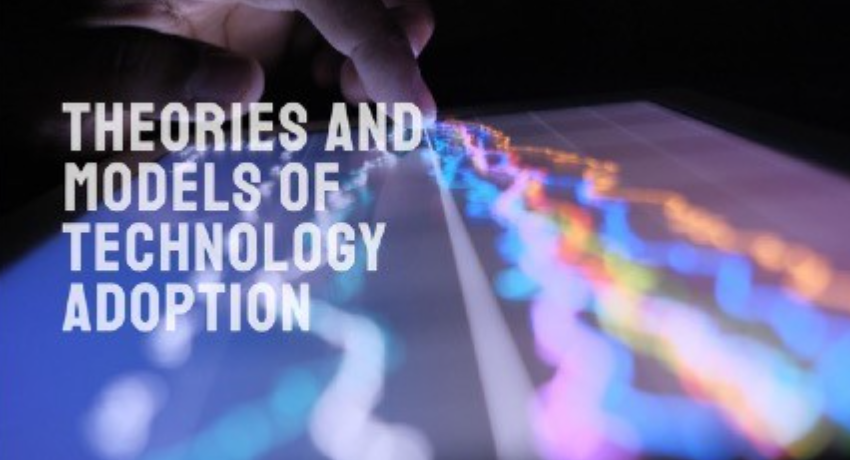Over the years several theories and models have been proposed to explain the acceptance of new technologies and the factors determining their adoption and use.
The Theory of Reasoned Action (TRA) proposed by Fishbein & Ajzen, 1975 is considered one of the most fundamental and influential theories of human behaviour. It suggests that attitude towards a behaviour and subjective norm determine an individual’s behavioural intention which in turn drives actual behaviour.
Individuals form attitudes towards a behaviour on the basis of expectations as a result of exhibiting that behaviour. The TRA ‘treats’ individuals as rational thinkers, which is seen as a weakness of the theory by some.
Davis, 1989, built upon the TRA to propose the Technology Adoption Model (TAM) which suggests that perceived ease of use (PEOU) and perceived usefulness (PU) of a system are the main determinants of a user’s attitude towards using it.
TAM has evolved to be the most popular model used to acceptance of innovation in the field of IT and IS.
In simple terms, the model states that the way an individual perceives the features/attributes of a system as useful and easy to use dictates the overall attitude towards using that system.
Several variations of the TAM have been proposed over the years.
While there is evidence to support the existence of a causal relation between behavioural intention and actual behaviour, the model is also criticised for its limitation to take into consideration real life constraints, such as limited ability and unconscious habits of users which limit the freedom to act.
For that, Davis et al., 1992 proposed the Motivational Model which suggests that intrinsic and extrinsic motivation influences behaviour.
Briefly, extrinsic motivation refers to reasons that make an individual wanting to perform an activity because it can lead to the achievement of outcomes of value. Intrinsic motivation relates to the enjoyment and satisfaction arising from performing an activity.
And Ajzen, 1991 extended the TRA to the Theory of Planned Behaviour by also including the construct of perceived behavioural control which refers to ‘the perceived ease or difficulty of performing the behaviour’.
Bandura, 1986 proposed the Social Cognitive Theory (SCT). Put in simple terms a person’s cognitive competences influence his/her attitude towards using a technology but the use of the technology also influences back the person’s perceptions. This reciprocity in the relation is something not accounted for by other technology acceptance models. The theory introduces the concepts of self-efficacy and outcome expectations which -together with- affect and anxiety influence usage and are influenced back by it.
Outcome expectations are divided into personal which address a person’s esteem and sense of accomplishment and performance-related expectations which relate to job performance outcomes.
Rogers proposed the innovation diffusion theory (IDT) has been extensively used in the study of innovations. IDT introduces the innovation-decision process that describes the steps an entity goes through in deciding whether to adopt an innovation.
For someone to consider the adoption of an innovation he/she first needs to be aware of it.
This is a cognitive process whereby the individual gains awareness and then seeks to find out more about the innovation. In the persuasion stage the individual actively seeks to obtain more information, decides what messages he/she regards as credible and decides how he/she interprets the information received.
The individual will form a favourable or unfavourable attitude towards the innovation and he/she might want social reinforcement of his/her attitude from others.
At the decision stage, the individual makes a choice to either reject or adopt. Provided that the individual has chosen to adopt the innovation, he/she will start using it during the implementation stage.
There can still be a certain degree of uncertainty during this stage which can potentially lead to discontinuance. Re-invention, which Rogers, 1995, defines as ‘the process by which a person adapts or modifies a technology to better fit his/her needs’, could occur during this stage. At the confirmation stage the individual will eventually either decide to carry on using the service or not.
Rogers identified five attributes of an innovation that influence the decision of individual to adopt or reject the innovation. These are relative advantage, compatibility, complexity, trialability and observability. These attributes are also determinants of the rate of adoption of the innovation but we will not discuss any further as the rate of adoption is beyond the scope of this study.
Moore and Benbasat, 1991, have also added image and voluntariness of use in the attribute set. They defined image as ‘the degree to which use of an innovation is perceived to enhance one’s image or status in his/her social system’ and voluntariness of use as ‘the degree to which use of the innovation is perceived as being voluntary’.
Venkatesh et al., 2003 combined eight models of technology and proposed the UTAUT. According to the Unified Theory of Acceptance and Use of Technology (UTAUT). Performance expectancy, effort expectancy and social influence are key determinants of usage behaviour. Age, gender, experience and voluntariness of use are treated as moderating factors. Even more, the theory introduces facilitating conditions -the degree to which an individual believes that an organizational and technical infrastructure exists to support use of the system.
Depending on the technology and its application other key factors influencing adoption such as cost, trust, security and privacy have been brought into models and theories.
There is significant empirical evidence on these theories and models. Davis, 1989, Venkatesh and Davis, 2000, and Venkatesh et al., 2003 have found that PU is the strongest predictor of intention to use an IT system. Agarwal and Prasad, 1997, note that ‘ease of use did not appear as a significant determinant’.
Several other researchers have arrived to similar conclusions. Davis, 1989, also posits that PEOU has an influence on PU rather than a direct influence on usage. However, Chau and Hu, 2001, concluded that ‘perceived ease of use was not found to have any significant effects on perceived usefulness or attitude’.
There is however no agreement as to whether social norms influence intention to use. For example, Davis, 1989, and Chau and Hu, 2001, conclude that social norms are not important, Karahanna and Straub, 1999, Schepers and Wetzel, 2007, posit that social norms are important.
By Theodoros Loukaidis
Director General at Cyprus Research and Innovation Foundation 









